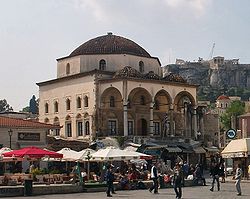This article includes a list of references, related reading, or external links, but its sources remain unclear because it lacks inline citations .(May 2017) |
 | |
 | |
| Established | 1918 (present location 1973) |
|---|---|
| Location | 17 Kydathinaion Str., Plaka, Athens, Greece |
| Type | Folk art museum |
| Public transit access | Athens Metro stations: Syntagma Station |
| Website | www |
The Museum of Greek Folk Art is a museum in Athens, Greece. The museum was founded in 1918 as the Museum of Greek Handicrafts in the Tzistarakis Mosque in Monastiraki, which later became the National Museum of Decorative Arts and in 1959 it obtained its current name. In 1973 the greater part of the collection and the main functions of the museum were moved to 17 Kydathinaion Str. in Plaka and the mosque was annexed to it. Other annexes are the old "Public Baths" at Kyrristou 8 and one at Thespidos 8, both also in Plaka.

